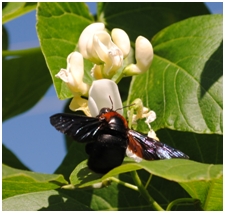Do French beans (Phaseolus vulgaris L.) grown in proximity to Mt Kenya forest- Kenya- experience pollination deficit?
DOI:
https://doi.org/10.26786/1920-7603(2013)25Abstract
Yields of commercially important crops in Kenya are often far below their potential. Amongst the possible reasons for such low yields may be the ecosystem degradation that can be expected to have negative impacts on pollinator presence in cropland, and the consequent food security issue for smallholder farmers who depend on these crops for their livelihood. Our study was carried out to assess the potential pollination deficit of French beans (Phaseolus vulgaris L.), a major export vegetable crop in Kenya grown by small-scale farmers. Sufficient pollination of French beans likely results in high seed set and uniform heavier green pods. Such pods get the highest grade while malformed pods are unmarketable, reducing family income. We hypothesized that pollination success was linked to the abundance and diversity of large pollinators, itself associated with the proximity to natural habitats. Flower visitors to French beans were sampled in 2011 and 2012 in ten farmer-managed plots, five within 200 m from the edge of Mt. Kenya forest and five farther away, more than 1000 m. Each plot measured 760 m2 and was planted at the same time, with the “Julia” variety. Flowers were observed for 2 h in each plot once weekly for three weeks at peak flowering from 0900-1100 h in the morning and 1200 – 1400 h in the afternoon on alternate days. Honey bees (Apis mellifera) were the most abundant visitors of French bean flowers followed by carpenter bees (Xylocopa spp.) and leafcutter bees (Megachile spp.). Significantly higher numbers of leafcutter bees were recorded on farms far to the forest. There was no significant difference in honeybee abundance among the study sites, probably because apiaries and wild colonies are located across the landscape. French bean yield was significantly correlated with the mean abundance of carpenter bees in 2011. This suggests the possible occurrence of pollination deficit in French beans where the density of carpenter bees is insufficient, which was reflected by the high variability of yields in the farmland. We advocate that area-wide management and conservation of carpenter bees should be initiated to support French bean farming in the area.
Downloads
Published
How to Cite
Issue
Section
License
Copyright (c) 2014 Rose Masiga, Muo Kasina, Jenard Mbugi, Christopher Odhiambo, Wanja Kinuthia, Barbara Gemmill-Herren, Bernard Vaissière

This work is licensed under a Creative Commons Attribution 4.0 International License.
JPE is an open access journal which means that all content is freely available without charge to the user or his/her institution.
Authors who publish with this journal agree to the following terms:
1) Authors retain copyright and grant the journal right of first publication with the work simultaneously licensed under a Creative Commons Attribution License that allows others to share the work with an acknowledgement of the work's authorship and initial publication in this journal.
2) Authors are able to enter into separate, additional contractual arrangements for the non-exclusive distribution of the journal's published version of the work (e.g., post it to an institutional repository or publish it in a book), with an acknowledgement of its initial publication in this journal.
3) Authors are permitted and encouraged to post their work online (e.g., in institutional repositories or on their website) prior to and during the submission process, as it can lead to productive exchanges, as well as earlier and greater citation of published work (See The Effect of Open Access).
To assure a broader targeted audience, content will be included into databases (such as EBSCO) and directories (such as DOAJ).











